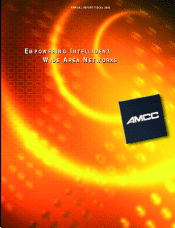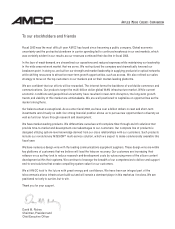3Ware 2003 Annual Report Download - page 8
Download and view the complete annual report
Please find page 8 of the 2003 3Ware annual report below. You can navigate through the pages in the report by either clicking on the pages listed below, or by using the keyword search tool below to find specific information within the annual report.decreased capital expenditures on networking equipment in an effort to stabilize their financial condition and
many of the emerging carriers were unable to attract sufficient customers and failed.
Due to this downturn, we experienced a significant drop in sales and orders of our products, and a sharp
increase in order cancellations during fiscal 2002. In fiscal 2003, the contraction of carrier capital spending on
networking equipment continued, resulting in a further decline in orders and sales of our products. The impact of
this downturn has been magnified by the high levels of inventory that existed in the supply chain at the beginning
of the downturn.
The Communications IC Opportunity
Despite the industry downturn, industry analysts report that network traffic continues to grow at a rapid
pace. The continuing adoption of broadband technology and next-generation wireless devices is expected to drive
additional data traffic through the network infrastructure in the future. To address these opportunities, OEMs are
looking to develop systems that are more economically suitable to capitalize on these opportunities. To achieve
the performance and functionality required by such systems, these OEMs must utilize more complex ICs. As a
result of the pace of new product introductions, the proliferation of standards to be accommodated and the costs
and difficulty of designing and producing the required ICs, equipment suppliers have increasingly outsourced
these ICs to semiconductor firms with specialized expertise. These trends have created a significant opportunity
for IC suppliers that can design cost-effective solutions for the transmission of data. IC suppliers must utilize a
variety of skills and technologies to satisfy the requirements of communications OEMs. These OEMs require IC
suppliers that possess system-level expertise and can quickly bring to market high-performance, highly reliable,
power-efficient ICs. These OEMs seek suppliers with both analog and digital expertise to provide a more
complete solution that enables faster integration into the system design and higher performance.
The Transition from ASICs to ASSPs
Application specific integrated circuits, known by the acronym ASICs, are custom products that are
designed for only one customer, and can be sold only to that one customer. Application specific standard
products, known by the acronym ASSPs, are standardized products that are designed for, and can be used by,
multiple customers. Our customers are looking for ways to accelerate their time-to-market, reduce research and
development cost, and ensure interoperability of components in their systems. ASSPs generally can be designed
into the systems and brought to market in less time and for less cost. As more companies realize the development
cost and time-to-market benefits that ASSPs provide, the more apt they are to use ASSPs in the future. Most of
our products are ASSPs, and we believe that the trend towards greater usage of ASSPs in communications
network systems will continue.
AMCC Strategy
Our objective is to be the leading supplier of high-performance, high-bandwidth silicon IC solutions for the
world’s wide area networks, including the optical core, metropolitan area networks and access networks. To
achieve this objective, we employ the following strategies:
Focus on the Market Leading Systems within the Wide Area Network Markets
We target key OEM product families that hold significant and/or rapidly growing market share. We have
built substantial competencies focused on the specific requirements of these key OEM product families in the
areas of semiconductor process technology, mixed-signal, very dense digital design, and substantial expertise in
systems architecture, software and applications support. We believe that the integration of these capabilities
enables us to optimize solutions addressing the high-bandwidth connectivity requirements of market leading
communications equipment suppliers.
3





















